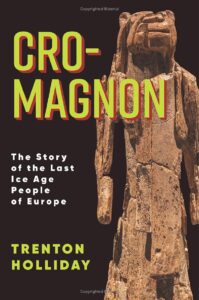By Trenton W Holliday

The Cro-Magnons were a population of early modern humans (that is, they were physically indistinguishable from us, today), who lived in Europe between about 40,000 and 10,000 years ago, during the Upper Palaeolithic period.
They are often considered to be one of the earliest examples of anatomically and behaviourally modern humans. In fact, the term ‘Cro-Magnon’ is often used interchangeably with ‘European Upper Palaeolithic humans’. These individuals were known for their sophisticated tools, art and culture. They created intricate cave paintings and sculptures, many of which have been found in various archaeological sites throughout Europe, such as the magnificent images found in Lascaux Cave, in France.
It is also clear that the Cro-Magnons were skilled hunters and gatherers, relying on a variety of animals and plant resources for their survival. During the last ice age, Europe was a cold, dry place, but it was still teeming with mammoths, woolly rhinoceroses, reindeer, bison, cave bears, cave hyenas and cave lions. Our knowledge of them comes from either their skeletons or the tools, art, and debris they left behind.
This information comes from Trenton Holliday’s excellent book, which tells the story of these people in the context of recent scientific advances. However, while it does not shy away from complex scientific issues, the book is written with a light, understandable touch.
Holliday is a US paleoanthropologist, who has studied the Cro-Magnons throughout his career, in particular, in mainland Europe (there are only a few Cro Magnon remains from the UK). In his book, he asks questions such as:
- Where/when did anatomically modern humans first emerge, and when did they reach Europe, and how did they get there?
- Did they interact with (including breeding with) Neandertals?
- What did they look like?
- What did they eat, and how did they get their food as hunter gatherers?
- What do their skeletons tell us about their lives?
- How did they cope with the ice age cold and how did they respond to postglacial warming, 12,000 years ago?
- And, what does their art tell us about them?
These are big and wide-ranging questions, but Holliday offers new insights from two perspectives:
- firstly from the point of view of the biological anthropologist, who studies evolution, behaviour, and genetic and morphological variations; and
- secondly, from the perspective derived from Palaeolithic archaeology – that is, from the debris left behind by these prehistoric persons.
I think this was a fascinating book, and easy to read. You will learn a great deal about these early Europeans and I heartily recommend it.
Trenton Holliday is a paleoanthropologist, who was involved in the discovery of Homo naledi, found in the Dinaledi Chamber of the Rising Star Cave system in South Africa in 2015. He is a professor and Anthropology Department Chair at Tulane University in New Orleans, Louisiana, where he teaches human evolution, functional morphology, and modern human adaptation and variation. He studies the origins of Homo sapiens, the origin of the genus Homo, the fate of the Neanderthals, hybridisation among extant mammals, and late Australopithecus.
Holliday got his BA in anthropology from Louisiana State University (1988) and MA (1991) and PhD (1995) in anthropology in the University of New Mexico.
Cro-Magnon: The Story of the Last Ice Age People of Europe, by Trenton W Holliday, Columbia University Press, New York (2023), 296 pages (paperback), ISBN: 978-0231204965.


